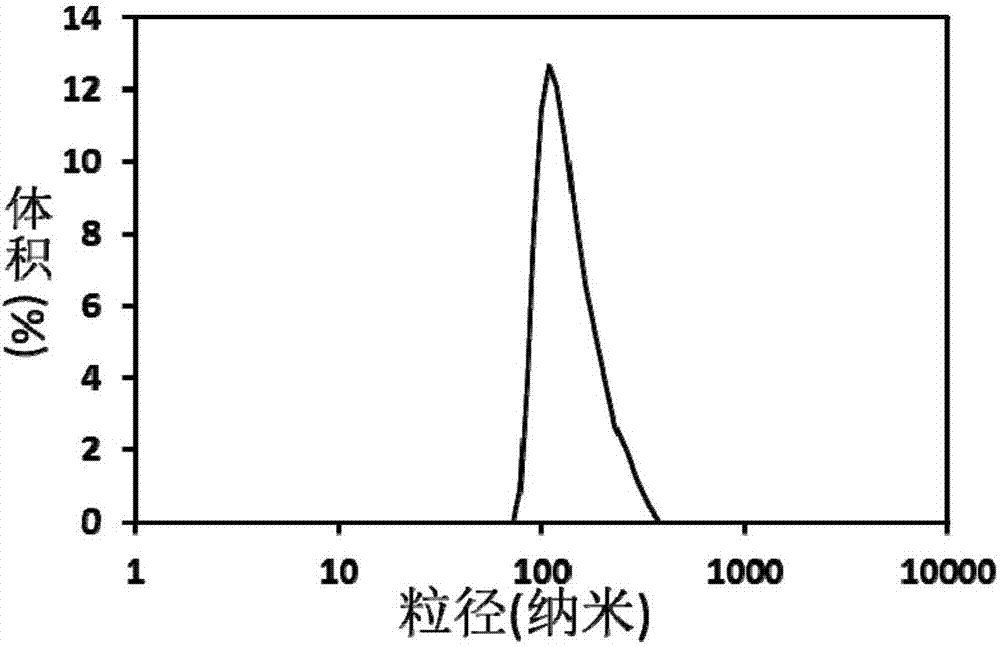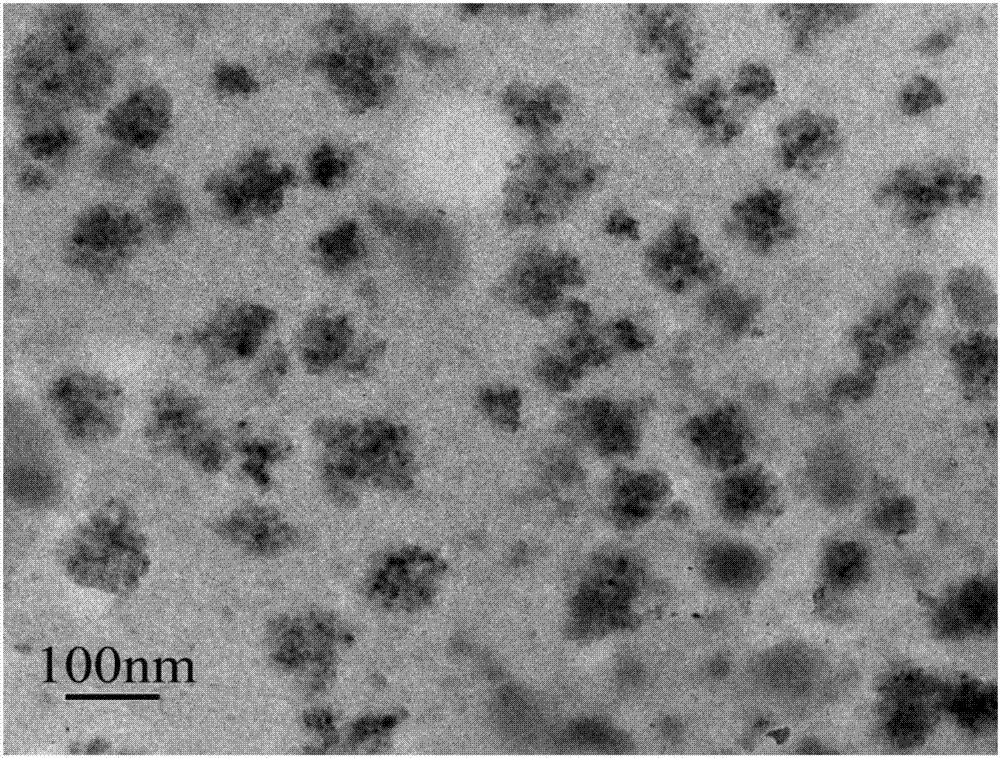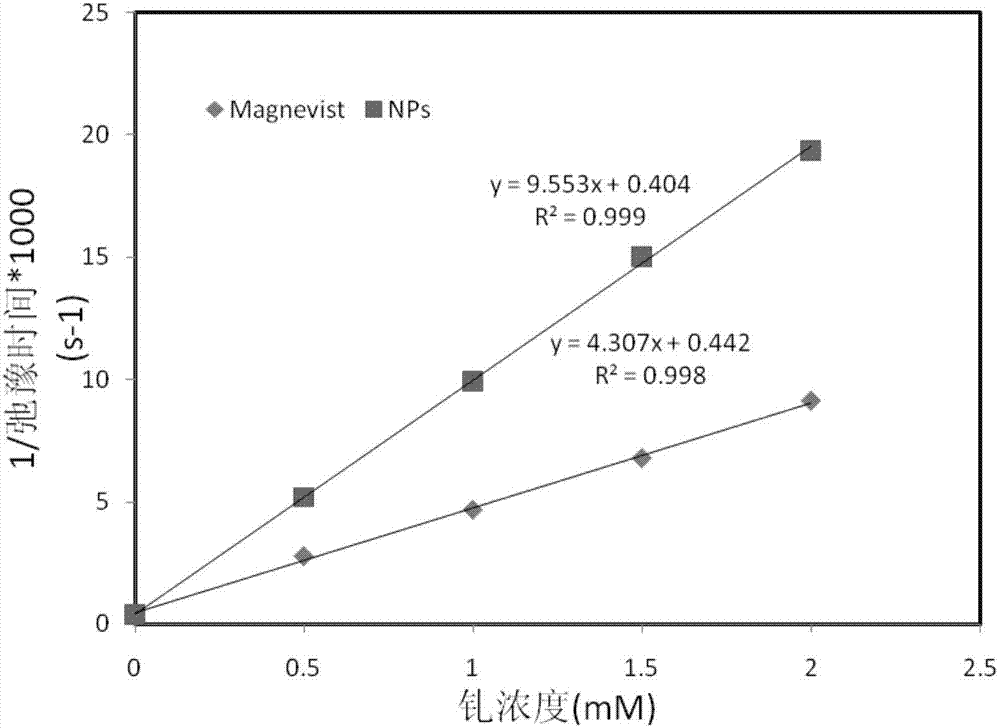Nanometer material for magnetic resonance imaging and/or photo-thermal treatment and preparation method thereof
A technology of magnetic resonance imaging and nanomaterials, applied in preparations for in vivo experiments, wave energy or particle radiation treatment materials, medical preparations containing active ingredients, etc., can solve the problem of high osmotic pressure, lack of tissue and organ selection Targeting and targeting, short retention time and other issues, to achieve the effects of targeting and less toxic side effects, long circulation time in the body, and good contrast effect
- Summary
- Abstract
- Description
- Claims
- Application Information
AI Technical Summary
Problems solved by technology
Method used
Image
Examples
Embodiment 1
[0043] 1. Preparation of nanomaterials
[0044] (1) Add mPEG-DA (131.09mg; 2eq), DTPA(HTA) to 25mL deionized water 2 @Gd (25mg; 1eq), CuSO 4 ·5H 2 O (125mg), make Cu in the system 2+ The concentration was 20mM, and reacted at 80°C for 5h.
[0045] (2) Dialysis (Mw=2000) for 72 hours.
[0046] (3) freeze-drying.
[0047] 2. Performance analysis of nanomaterials
[0048] Such as figure 1 As shown, the volume average particle diameter of the nanomaterial measured by dynamic light scattering (DLS) is 115 nm (distribution coefficient PDI=0.235).
[0049] Such as figure 2 As shown, the particle size of nanomaterials observed by transmission electron microscopy (TEM) is 100nm, which is consistent with the particle size results measured by DLS.
[0050] Such as image 3 As shown, the R1 value of Magnevist was determined to be 4.3mM -1 ·s -1 , consistent with the literature. The nanomaterial has a gadolinium content of 4% and a relaxation rate R1 value of 9.55mM -1 ·s -...
Embodiment 2
[0060] Nanomaterials were prepared according to the reaction conditions in Table 1, and the process flow was referred to in Example 1. Table 1 shows the particle size results of the obtained products.
[0061] Table 1
[0062]
[0063]
[0064] A: Dopamine modified DTPA-Gd
[0065] B: Dopamine-modified PEG
[0066] It can be seen from the above table that when the copper ion concentration is greater than 40 mM or less than 10 mM, the size of the nanomaterials is too large. Particles that are too large cannot be enriched in tumor tissue through the EPR effect, and are easily trapped by the reticuloendothelial system. Therefore, they are not suitable for use as the magnetic resonance imaging contrast agent and photothermal therapy agent of the present invention.
[0067] If the heating temperature exceeds 90°C, the prepared nanomaterials will have the problem of non-uniform particle size, which will affect their use effect.
PUM
| Property | Measurement | Unit |
|---|---|---|
| Volume average particle size | aaaaa | aaaaa |
| Particle size | aaaaa | aaaaa |
| Relaxation rate | aaaaa | aaaaa |
Abstract
Description
Claims
Application Information
 Login to View More
Login to View More - R&D
- Intellectual Property
- Life Sciences
- Materials
- Tech Scout
- Unparalleled Data Quality
- Higher Quality Content
- 60% Fewer Hallucinations
Browse by: Latest US Patents, China's latest patents, Technical Efficacy Thesaurus, Application Domain, Technology Topic, Popular Technical Reports.
© 2025 PatSnap. All rights reserved.Legal|Privacy policy|Modern Slavery Act Transparency Statement|Sitemap|About US| Contact US: help@patsnap.com



